形容词、副词比较级和最高级用法讲解
形容词、副词的比较级和最高级的用法
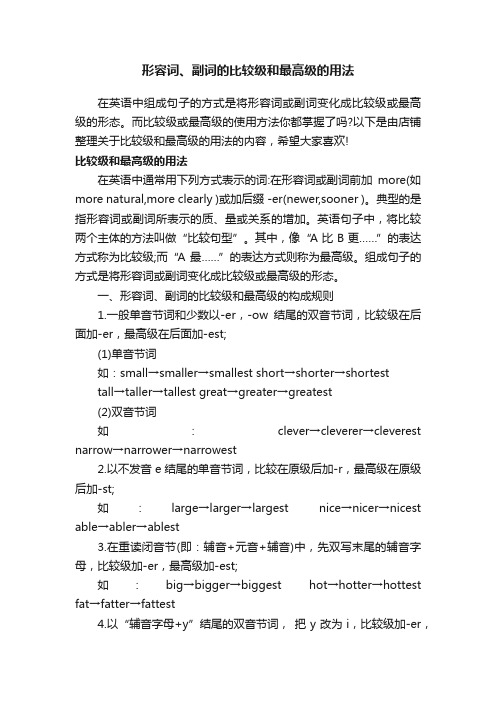
形容词、副词的比较级和最高级的用法在英语中组成句子的方式是将形容词或副词变化成比较级或最高级的形态。
而比较级或最高级的使用方法你都掌握了吗?以下是由店铺整理关于比较级和最高级的用法的内容,希望大家喜欢!比较级和最高级的用法在英语中通常用下列方式表示的词:在形容词或副词前加more(如more natural,more clearly )或加后缀 -er(newer,sooner )。
典型的是指形容词或副词所表示的质、量或关系的增加。
英语句子中,将比较两个主体的方法叫做“比较句型”。
其中,像“A比B更……”的表达方式称为比较级;而“A最……”的表达方式则称为最高级。
组成句子的方式是将形容词或副词变化成比较级或最高级的形态。
一、形容词、副词的比较级和最高级的构成规则1.一般单音节词和少数以-er,-ow结尾的双音节词,比较级在后面加-er,最高级在后面加-est;(1)单音节词如:small→smaller→smallest short→shorter→shortesttall→taller→tallest great→greater→greatest(2)双音节词如:clever→cleverer→cleverest narrow→narrower→narrowest2.以不发音e结尾的单音节词,比较在原级后加-r,最高级在原级后加-st;如:large→larger→largest nice→nicer→nicest able→abler→ablest3.在重读闭音节(即:辅音+元音+辅音)中,先双写末尾的辅音字母,比较级加-er,最高级加-est;如:big→bigger→biggest hot→hotter→hottest fat→fatter→fattest4.以“辅音字母+y”结尾的双音节词,把y改为i,比较级加-er,最高级加-est;如:easy→easier→easiest heavy→heavier→heaviestbusy→busier→busiest happy→happier→happiest5.其他双音节词和多音节词(一个元音为一个音节)比较级在前面加more,最高级在前面加most;如:beautiful→more beautiful→most beautifuldifferent→more different→most differenteasily→more easily→most easily注意:(1)形容词最高级前通常必须用定冠词the,副词最高级前可不用。
形容词和副词的比较级与最高级用法总结与解析
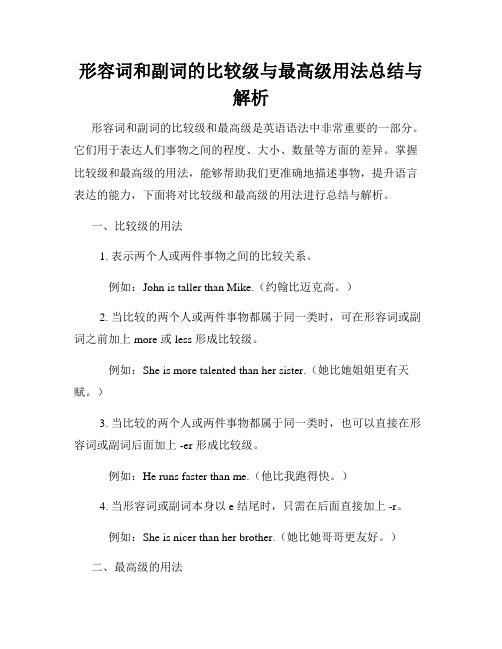
形容词和副词的比较级与最高级用法总结与解析形容词和副词的比较级和最高级是英语语法中非常重要的一部分。
它们用于表达人们事物之间的程度、大小、数量等方面的差异。
掌握比较级和最高级的用法,能够帮助我们更准确地描述事物,提升语言表达的能力,下面将对比较级和最高级的用法进行总结与解析。
一、比较级的用法1. 表示两个人或两件事物之间的比较关系。
例如:John is taller than Mike.(约翰比迈克高。
)2. 当比较的两个人或两件事物都属于同一类时,可在形容词或副词之前加上 more 或 less 形成比较级。
例如:She is more talented than her sister.(她比她姐姐更有天赋。
)3. 当比较的两个人或两件事物都属于同一类时,也可以直接在形容词或副词后面加上 -er 形成比较级。
例如:He runs faster than me.(他比我跑得快。
)4. 当形容词或副词本身以 e 结尾时,只需在后面直接加上 -r。
例如:She is nicer than her brother.(她比她哥哥更友好。
)二、最高级的用法1. 表示三个或三个以上人或事物之间的比较关系。
例如:He is the tallest among all the students.(他是全班同学中最高的。
)2. 当比较的三个或三个以上人或事物都属于同一类时,可在形容词或副词之前加上 most 或 least 形成最高级。
例如:It's the most beautiful place I have ever seen.(那是我见过的最美的地方。
)3. 当比较的三个或三个以上人或事物都属于同一类时,也可以直接在形容词或副词后面加上 -est 形成最高级。
例如:This is the fastest car in the world.(这是全世界最快的车。
)4. 如果形容词或副词本身以辅音字母 + y 结尾,则将 y 变为 i,再加上 -est。
形容词,副词的比较级、最高级语法知识详解
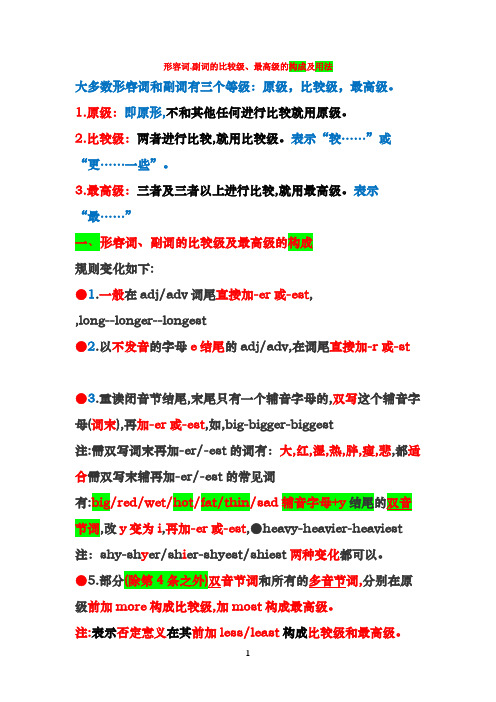
形容词,副词的比较级、最高级的构成及用法大多数形容词和副词有三个等级:原级,比较级,最高级。
1.原级:即原形,不和其他任何进行比较就用原级。
2.比较级:两者进行比较,就用比较级。
表示“较……”或“更……一些”。
3.最高级:三者及三者以上进行比较,就用最高级。
表示“最……”一、形容词、副词的比较级及最高级的构成规则变化如下:●1.一般在adj/adv词尾直接加-er或-est,,long--longer--longest●2.以不发音的字母e结尾的adj/adv,在词尾直接加-r或-st●3.重读闭音节结尾,末尾只有一个辅音字母的,双写这个辅音字母(词末),再加-er或-est,如,big-bigger-biggest注:需双写词末再加-er/-est的词有:大,红,湿,热,胖,瘦,悲,都适合需双写末辅再加-er/-est的常见词有:big/red/wet/hot/fat/thin/sad辅音字母+y结尾的节词,改y变为i,再加-er或-est,●heavy-heavier-heaviest 注:shy-sh y er/sh i er-shyest/shiest两种变化都可以。
●5.和所有的多音节词,分别在原级前加more构成比较级,加most构成最高级。
注:表示否定意义在其前加less/least构成比较级和最高级。
important----less important----least important EnglishismoreinterestingthanChinese=Chineseislessinte restingthanEnglish.●6.由“形容词加-ly”构成的副词(除bad ly是不规则变化worse/worst),在其前加more/most构成比较级和最高级。
;但要注意:early不属于这一条。
early----earl i er----earliest●7.由“名词后加-ful”构成的形容词,都是在其前加more/most构成比较级和最高级。
形容词副词比较级和最高级用法总结
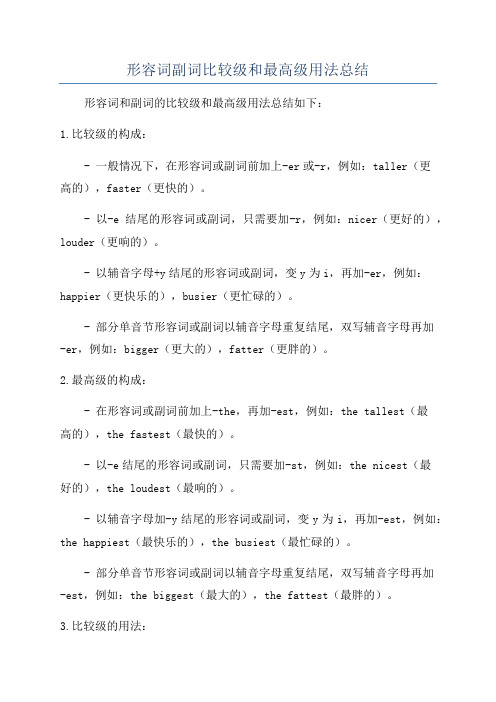
形容词副词比较级和最高级用法总结形容词和副词的比较级和最高级用法总结如下:1.比较级的构成:- 一般情况下,在形容词或副词前加上-er或-r,例如:taller(更高的),faster(更快的)。
- 以-e结尾的形容词或副词,只需要加-r,例如:nicer(更好的),louder(更响的)。
- 以辅音字母+y结尾的形容词或副词,变y为i,再加-er,例如:happier(更快乐的),busier(更忙碌的)。
- 部分单音节形容词或副词以辅音字母重复结尾,双写辅音字母再加-er,例如:bigger(更大的),fatter(更胖的)。
2.最高级的构成:- 在形容词或副词前加上-the,再加-est,例如:the tallest(最高的),the fastest(最快的)。
- 以-e结尾的形容词或副词,只需要加-st,例如:the nicest(最好的),the loudest(最响的)。
- 以辅音字母加-y结尾的形容词或副词,变y为i,再加-est,例如:the happiest(最快乐的),the busiest(最忙碌的)。
- 部分单音节形容词或副词以辅音字母重复结尾,双写辅音字母再加-est,例如:the biggest(最大的),the fattest(最胖的)。
3.比较级的用法:- 表示两个人或物之间的比较,例如:He is taller than me.(他比我高。
- 表示一些人或物在其中一方面的进步或退步,例如:She is getting smarter.(她越来越聪明)。
4.最高级的用法:- 表示三个或三个以上人或物之间的比较,例如:He is the tallest in the class.(他是班级里最高的)。
- 表示人或物在其中一方面的最高水平或程度,例如:She is the smartest student in the school.(她是学校里最聪明的学生)。
形容词与副词的比较级与最高级形式与用法
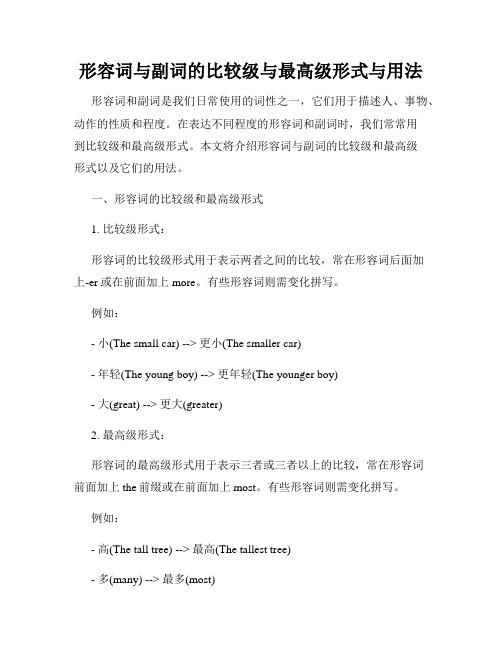
形容词与副词的比较级与最高级形式与用法形容词和副词是我们日常使用的词性之一,它们用于描述人、事物、动作的性质和程度。
在表达不同程度的形容词和副词时,我们常常用到比较级和最高级形式。
本文将介绍形容词与副词的比较级和最高级形式以及它们的用法。
一、形容词的比较级和最高级形式1. 比较级形式:形容词的比较级形式用于表示两者之间的比较,常在形容词后面加上-er或在前面加上more。
有些形容词则需变化拼写。
例如:- 小(The small car) --> 更小(The smaller car)- 年轻(The young boy) --> 更年轻(The younger boy)- 大(great) --> 更大(greater)2. 最高级形式:形容词的最高级形式用于表示三者或三者以上的比较,常在形容词前面加上the前缀或在前面加上most。
有些形容词则需变化拼写。
例如:- 高(The tall tree) --> 最高(The tallest tree)- 多(many) --> 最多(most)二、副词的比较级和最高级形式1. 比较级形式:副词的比较级形式与形容词相同,可以在后面加上-er或在前面加上more。
例如:- 快(He runs fast) --> 更快(He runs faster)- 悄悄地(Quietly) --> 更悄悄地(More quietly)2. 最高级形式:副词的最高级形式也与形容词相同,可以在前面加上most或在副词前面加上the前缀。
例如:- 很(nicely) --> 最(nicest)- 积极地(actively) --> 最积极地(the most actively)三、形容词和副词比较级与最高级的用法1. 更有多样性的比较:有些形容词和副词在比较级和最高级形式中有特殊变化。
例如:- 好(good) --> 更好(better) --> 最好(the best)- 多(多种方式)(many)--> 更多(more) --> 最多(the most)2. 不规则比较:有一些形容词和副词的比较级和最高级形式变化不规则,需特别注意。
中考形容词与副词中的比较级与最高级用法

中考形容词与副词中的比较级与最高级用法形容词和副词是英语语法中常见的词性,在句子中起到描述性和修饰性的作用。
比较级和最高级是形容词和副词的两种特殊形式,用来表示事物之间的比较关系。
在中考英语考试中,对于形容词和副词的比较级与最高级的用法要求掌握清楚。
本文将详细讲解中考形容词与副词中的比较级与最高级用法,并给出相关例句供参考。
一、形容词比较级的用法1. 与单音节形容词的比较级用法(1)一般在形容词后直接加-er,表示“比较……”。
例如:- She is taller than her sister.(她比她妹妹高。
)- The weather today is hotter than yesterday.(今天的天气比昨天热。
)(2)以“辅音字母+元音字母+辅音字母”的形式结尾的单音节形容词,要双写末尾的辅音字母,再加-er。
例如:- Big - bigger(大 - 更大)- Thin - thinner(瘦 - 更瘦)2. 与多音节形容词的比较级用法多音节形容词通常在前面加more或less,表示“更……”或“不太……”。
例如:- He is more intelligent than his classmates.(他比同学们更聪明。
)- This shirt is less expensive than that one.(这件衬衫比那件衬衫便宜。
)二、副词比较级的用法1. 与单音节副词的比较级用法(1)一般在副词后直接加-er。
例如:- She runs faster than me.(她跑得比我快。
)- He speaks louder than the others.(他说话声音比其他人大。
)(2)以不发音的-e结尾的副词,去掉e,再加-er。
例如:- Late - later(迟 - 更迟)- Safe - safer(安全 - 更安全)2. 与多音节副词的比较级用法多音节副词通常在前面加more或less。
形容词与副词的比较级与最高级用法
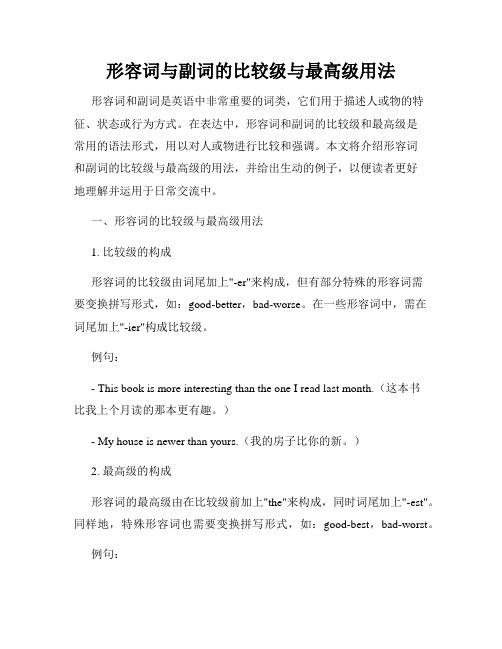
形容词与副词的比较级与最高级用法形容词和副词是英语中非常重要的词类,它们用于描述人或物的特征、状态或行为方式。
在表达中,形容词和副词的比较级和最高级是常用的语法形式,用以对人或物进行比较和强调。
本文将介绍形容词和副词的比较级与最高级的用法,并给出生动的例子,以便读者更好地理解并运用于日常交流中。
一、形容词的比较级与最高级用法1. 比较级的构成形容词的比较级由词尾加上"-er"来构成,但有部分特殊的形容词需要变换拼写形式,如:good-better,bad-worse。
在一些形容词中,需在词尾加上"-ier"构成比较级。
例句:- This book is more interesting than the one I read last month.(这本书比我上个月读的那本更有趣。
)- My house is newer than yours.(我的房子比你的新。
)2. 最高级的构成形容词的最高级由在比较级前加上"the"来构成,同时词尾加上"-est"。
同样地,特殊形容词也需要变换拼写形式,如:good-best,bad-worst。
例句:- This is the most beautiful flower I have ever seen.(这是我见过的最美丽的花。
)- He is the smartest student in our class.(他是我们班最聪明的学生。
)3. 比较级与最高级的用法- 形容词的比较级常用于两个人或物的比较。
例句:- John is taller than his brother.(约翰比他的弟弟高。
)- This dress is more expensive than that one.(这件连衣裙比那件贵。
)- 形容词的最高级用于三个或三个以上人或物的比较。
例句:- Mary is the oldest of the three sisters.(玛丽是三个姐妹中最年长的一个。
形容词和副词的比较级与最高级用法
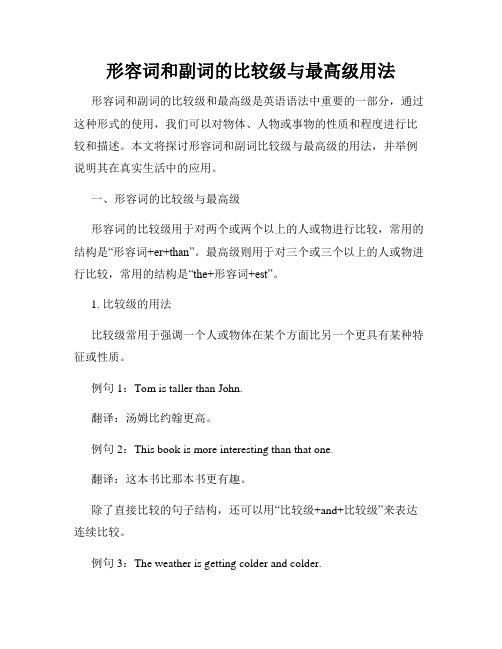
形容词和副词的比较级与最高级用法形容词和副词的比较级和最高级是英语语法中重要的一部分,通过这种形式的使用,我们可以对物体、人物或事物的性质和程度进行比较和描述。
本文将探讨形容词和副词比较级与最高级的用法,并举例说明其在真实生活中的应用。
一、形容词的比较级与最高级形容词的比较级用于对两个或两个以上的人或物进行比较,常用的结构是“形容词+er+than”。
最高级则用于对三个或三个以上的人或物进行比较,常用的结构是“the+形容词+est”。
1. 比较级的用法比较级常用于强调一个人或物体在某个方面比另一个更具有某种特征或性质。
例句1:Tom is taller than John.翻译:汤姆比约翰更高。
例句2:This book is more interesting than that one.翻译:这本书比那本书更有趣。
除了直接比较的句子结构,还可以用“比较级+and+比较级”来表达连续比较。
例句3:The weather is getting colder and colder.翻译:天气越来越冷。
2. 最高级的用法最高级用于强调一个人或物在某个方面超过其他所有人或物,是比较级的最高级形式。
例句4:He is the tallest boy in the class.翻译:他是班里最高的男孩。
例句5:This is the most delicious cake I have ever tasted.翻译:这是我尝过的最美味的蛋糕。
二、副词的比较级与最高级与形容词类似,副词的比较级和最高级也是用于对两个或两个以上的动作或状态进行比较和描述的。
常用的结构是“副词+er+than”和“the+副词+est”。
1. 比较级的用法副词的比较级用于对两个或两个以上的动作或状态进行程度上的比较。
例句6:He speaks English more fluently than his sister.翻译:他说英语比他妹妹更流利。
形容词和副词的比较级与最高级

形容词和副词的比较级与最高级形容词和副词的比较级与最高级是语法中基本的知识点之一,它用于比较事物之间的差异和层次。
在英语中,我们使用不同的后缀和规则来构成比较级和最高级。
本文将介绍形容词和副词比较级与最高级的相关规则和用法。
一、形容词的比较级与最高级1. 形容词的比较级形容词的比较级用于比较两个事物之间的差异,表示其中一个事物具有更高或更低的程度。
1)规则变化:单音节或少数双音节形容词在词尾加-er构成比较级,如:tall(高)→ taller(更高);clever(聪明)→ cleverer(更聪明)。
部分双音节和多音节形容词在前面加more构成比较级,如:careful(小心的)→ more careful(更小心的);beautiful(美丽的)→ more beautiful(更美丽的)。
2)特殊变化:a. 以“e”结尾的形容词,在词尾加-r,如:large(大)→ larger(更大);safe(安全的)→ safer(更安全的)。
b. 以“辅音字母+y”结尾的形容词,变“y”为“i”,再加-er,如:happy(高兴的)→ happier(更高兴的)。
c. 部分以“辅音字母+元音字母+辅音字母”结尾的形容词,双写最后一个辅音字母,再加-er,如:big(大)→ bigger(更大)。
2. 形容词的最高级形容词的最高级用于比较三个或三个以上事物之间的差异,表示其中一个事物具有最高或最低的程度。
1)规则变化:在比较级的基础上,加上最前面加the,再加上-est构成最高级,如:tall(高)→ the tallest(最高的);clever(聪明)→ the cleverest(最聪明的)。
部分双音节和多音节形容词在前面加the most构成最高级,如:careful(小心的)→ the most careful(最小心的);beautiful(美丽的)→ the most beautiful(最美丽的)。
形容词和副词的比较级和最高级全面解析

形容词和副词的比较级和最高级形容词和副词的比较级和最高级的用法是初二上册新教材的重要考点,同时也是中考必须掌握的重要内容。
本文主要从形容词副词比较等级的变化、用法、及易错点三大方面对相关知识点进行详细解析,希望对同学们有所帮助。
一. 形容词和副词的比较级和最高级的变化方法如下:(1) 规则变化表:(2)几个不规则的形容词和副词的比较级和最高级如下表:二.形容词和副词比较级的基本用法注:如果动词是及物或不及物动词,则后面用副词;如果后面是连系动词,则后面用形容词。
如:This car is the fastest of the four.(形容词)(这辆汽车是四辆之中最快的)This car runs (the) fastest of the four.(副词)(这辆汽车是四辆之中跑得最快的)三.形容词副词比较级最高级的特殊用法(1)和冠词连用the +形容词原级+v(复),指一类人或物the +形容词比较级,指两者中“较…的”的那一个,eg. the younger of the twoa/ an +形容词比较级eg. The pen is expensive. I want a cheaper one.( a) +most+形容词最高级“非常…”eg. a most beautiful city(2)序数词及最高级连用,如:Flying is the fastest and the second cheapest way to travel.(3)比较级+than any other +n. (单)(适用于范围一致时)(all) other +n.(复)any +n.(单) (适用于范围不一致时) He is taller than any other student / all other students in his class.any student in my class.(4)倍数表达法。
形容词和副词比较级和最高级的用法总结

形容词和副词比较级和最高级的用法总结1.比较级的构成:形容词/副词的比较级通常在原词后面加上"-er"或者在前面加上"more",如:taller, more beautiful。
不规则变化的比较级词有:good-better, bad-worse, far-further/farther。
2.最高级的构成:形容词/副词的最高级通常在原词后面加上"-est"或者在前面加上"most",如:tallest, most beautiful。
不规则变化的最高级词有:good-best, bad-worst, far-furthest/farthest。
3.比较级和最高级的使用:a.对比两个人或事物时,用于比较它们之间的程度或大小。
例:She is taller than me.(她比我高。
)b.用于句子中表示不同程度的形容词或副词。
例:He runs faster than his brother.(他跑得比他弟弟快。
)c.用于句子中表示同一事物在不同时间或情况下的变化。
例:She is getting more and more beautiful.(她变得越来越漂亮。
)d.用于表示最高程度的形容词或副词。
例:He is the tallest boy in the class.(他是班上最高的男孩。
)4.注意事项:a. 一些形容词和副词的比较级和最高级形式与原形相同,只需要在前面加上"more"或"most"来表示比较级和最高级。
例:brave - braver - bravest , more brave - most braveb.使用比较级时,必须与被比较的人或事物进行比较,不能单独使用。
例:She is taller.(错误)应改为 She is taller than him.(她比他高。
形容词与副词的比较级与最高级用法详解
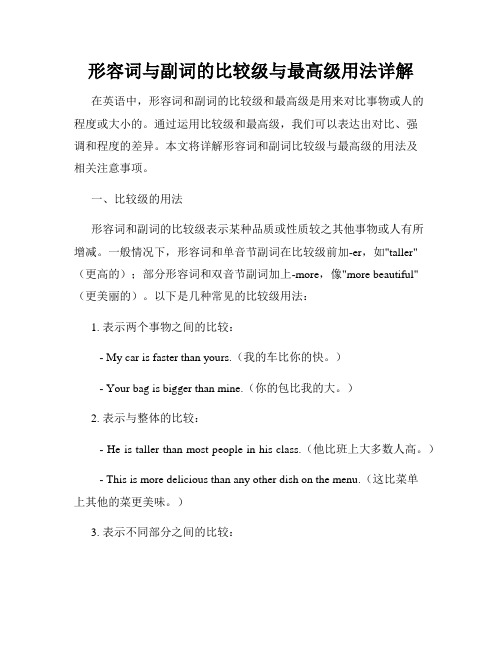
形容词与副词的比较级与最高级用法详解在英语中,形容词和副词的比较级和最高级是用来对比事物或人的程度或大小的。
通过运用比较级和最高级,我们可以表达出对比、强调和程度的差异。
本文将详解形容词和副词比较级与最高级的用法及相关注意事项。
一、比较级的用法形容词和副词的比较级表示某种品质或性质较之其他事物或人有所增减。
一般情况下,形容词和单音节副词在比较级前加-er,如"taller"(更高的);部分形容词和双音节副词加上-more,像"more beautiful"(更美丽的)。
以下是几种常见的比较级用法:1. 表示两个事物之间的比较:- My car is faster than yours.(我的车比你的快。
)- Your bag is bigger than mine.(你的包比我的大。
)2. 表示与整体的比较:- He is taller than most people in his class.(他比班上大多数人高。
) - This is more delicious than any other dish on the menu.(这比菜单上其他的菜更美味。
)3. 表示不同部分之间的比较:- The northern part of the country is colder than the southern part.(这个国家的北部气候比南部寒冷。
)- She is more talented in singing than in dancing.(她在唱歌方面的才华比跳舞更出色。
)二、最高级的用法形容词和副词的最高级表示某种品质或性质在同一类事物或人中达到最高点。
一般情况下,形容词和单音节副词在最高级前加-the,如"the tallest"(最高的);部分形容词和双音节副词加上-the most,像"the most beautiful"(最美丽的)。
形容词、副词的比较级与最高级用法详解精选全文完整版

可编辑修改精选全文完整版形容词、副词的比较级与最高级用法详解一、形容词、副词比较级、最高级构成大多数的形容词、副词都具有原级、比较级和最高级三种形式。
而形容词、副词的比较级、最高级构成方式分规则变化和不规则变化。
其规则变化的方式详见下面个表:(一)规则变化:(1) 直接在词尾加-er, -est(2) 以不发音字母e 结尾的,在词尾加-r , -st(3)以“辅音字母+y“结尾的,把y 变i,再加-er , -est(4) 以辅音字母结尾的重读闭音节词汇,双写最后一个辅音字母,再加-er , -est(5) 部分双音节和多音节词,在其前加more, most(二)、不规则变化:比较级、最高级具有不规则变化形式的形容词和副词比较少,因此,需要大家逐一认真记忆。
详见下表:【妙记顺口溜】“坏”“病”两“多”和两“好”,一是“远”来,二是“老”,little 是“少”不是“小”。
二、形容词、副词比较级和最高级用法(一)形容词、副词比较级用法形容词、副词的比较级主要对两个的人或物在某种程度、性质上进行比较。
常见的形容词副词比较级用法如下:1.同级比较① A+be/v+as+原级+as+B A和B一样This room is as large as that one .这间房子和那间一样大(形容词)Tom writes as carefully as Kate.汤姆写字跟凯特一样认真。
(副词)②A+be/V+not+as(so)+级+as +B A 不如BTigers aren't as(so) dangerous as lions.老虎不如狮子危险。
(形容词)Mary didn't finish the work as(so) well as Lucy.玛丽完成这项工作不如露西好。
(副词)2.差极比较①A+be/v+比较级+B A比B更......This pen is newer than that one.这支钢笔比那支新。
形容词和副词的比较级最高级用法讲解

发音
有些形容词的比较级和最高级用—er和 --est 或 more和 most皆可,如:clever , lovely 等. 表示“较不……“和”最不……“时,可用less与least.
difficult Interesting
less difficult less interesting
lea、形容词比较级前可加数词,表示 “大(小)…多少” “长(短)…多少” eg:He is five years younger than me. 他比我小五岁。
10、表示倍数时用:…times+比较级+than… eg:My room is three times bigger than yours.
7/10/2014
原级常用的句型结构
1.表示比较双方程度不同时常用“not as/ so +形容词/副词 +as”结构,意为“….不如…” =less +原级结构示表示降级的比较级.意为“……不如……”. He is not as (so) tall as Lilei=He is less tall than Lilei. She does not study so well as I do=She studies less well than I. 2. 在同级比较中可以在第一个as前加half,twice,three/four times 等词来表示倍数关系 Their school is three times as large as ours.
另:在一定的上下文中,形容词最高级后面的名词可省去处 eg: He is the youngest in the class.
7/10/2014
三、形容词和副词比较级的用 法 1.表示两者之间的选择 ,
形容词副词比较级和最高级的区别和用法

形容词副词比较级和最高级的区别和用法形容词和副词是我们在日常生活中经常使用的词性,比较级和最高级是它们常用的语法形式。
本文将详细探讨形容词副词比较级和最高级的区别和用法。
1. 形容词比较级的用法形容词比较级常用于对两个事物或人物进行比较,表示其中一个比另一个更具有某个性质。
常见的形容词比较级的构成方式是在词尾加上-er或者在前面加上more。
比如:- Tom is taller than Jerry.(汤姆比杰瑞更高。
)- This book is more interesting than the previous one.(这本书比上一本更有趣。
)需要注意的是,有些形容词是不规则比较级的,比如good(好)的比较级是better(更好),bad(坏)的比较级是worse(更坏)。
2. 形容词最高级的用法形容词最高级用于对三个或三个以上的事物或人物进行比较,表示其中一个具有某个性质的程度是最高的。
常见的构成方式是在词尾加上-est或者在前面加上most。
比如:- This is the tallest building in the city.(这是城市里最高的建筑。
)- Among all the students, Mary is the most intelligent.(在所有学生中,玛丽是最聪明的。
)同样地,有些形容词是不规则最高级的,比如good的最高级是best (最好),bad的最高级是worst(最坏)。
3. 副词比较级的用法副词比较级的用法与形容词比较级类似,表示一个动作或状态的程度比另一个更高。
常见的构成方式是在词尾加上-er或者在前面加上more。
比如:- He ran faster than his brother.(他跑得比他兄弟快。
)- She sings more beautifully than her friend.(她唱得比她朋友更美妙。
)同样地,有些副词也有不规则比较级形式,比如well(好)的比较级是better(更好),badly(糟糕地)的比较级是worse(更糟糕)。
英语形容词副词比较级和最高级用法区别归纳总结
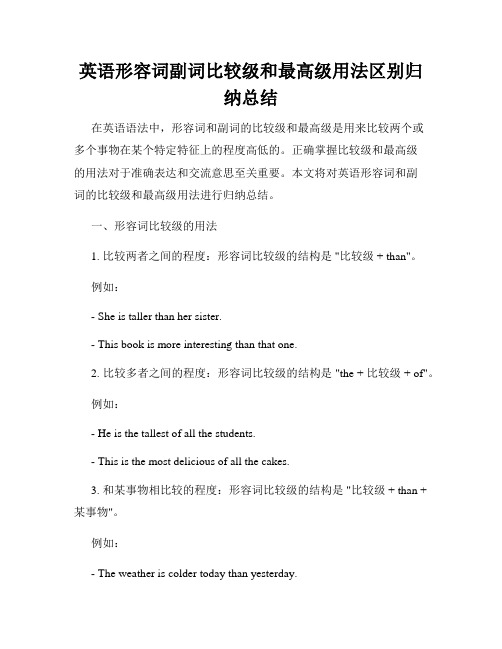
英语形容词副词比较级和最高级用法区别归纳总结在英语语法中,形容词和副词的比较级和最高级是用来比较两个或多个事物在某个特定特征上的程度高低的。
正确掌握比较级和最高级的用法对于准确表达和交流意思至关重要。
本文将对英语形容词和副词的比较级和最高级用法进行归纳总结。
一、形容词比较级的用法1. 比较两者之间的程度:形容词比较级的结构是 "比较级 + than"。
例如:- She is taller than her sister.- This book is more interesting than that one.2. 比较多者之间的程度:形容词比较级的结构是 "the + 比较级 + of"。
例如:- He is the tallest of all the students.- This is the most delicious of all the cakes.3. 和某事物相比较的程度:形容词比较级的结构是 "比较级 + than + 某事物"。
例如:- The weather is colder today than yesterday.- The new car is faster than the old one.二、形容词最高级的用法1. 在三者或更多者之间进行比较:形容词最高级的结构是 "the + 最高级 + of"。
例如:- This is the smallest of all the boxes.- She is the most intelligent of all the students.2. 和某事物比较的程度:形容词最高级的结构是 "the + 最高级 + 某事物"。
例如:- He is the oldest in his family.- This is the most expensive car in the showroom.三、副词的比较级和最高级用法1. 比较两者之间的程度:副词比较级的结构是 "比较级 + than"。
- 1、下载文档前请自行甄别文档内容的完整性,平台不提供额外的编辑、内容补充、找答案等附加服务。
- 2、"仅部分预览"的文档,不可在线预览部分如存在完整性等问题,可反馈申请退款(可完整预览的文档不适用该条件!)。
- 3、如文档侵犯您的权益,请联系客服反馈,我们会尽快为您处理(人工客服工作时间:9:00-18:30)。
形容词和副词比较级、最高级的用法
1.原级的构成和用法
l)构成:形容词,副词的原级形式是形容词,副词的原形.
2)用法:表示双方在程度,性质,特征等某方面相等时,用“as 十原级形容词或副词十as”的结构;表示双方不相等时,用“
not so (as)十原级形容词或副词十as”的结构;表示一方是另一方的若干倍时,用“倍数十as十原级形容词或副词十
as”的结构.
例如:
This building looks not so (as) high as that one.
Ms.Sun speaks English as fluently as you.
This room is three times as large as that one.
2.比较级和最高级的构成和用法
1)比较级和最高级的构成:
①单音节形容词以及少数以- er,- ow结尾的形容词和副词加“er”,“est”.例如:
great greater greatest narrow narrower narrowest
fast faster fastest clever cleverer cleverest
②以e结尾的单音节形容词和副词后以及少数以- ble,- ple结尾的双音节形容词和副词后,加“r”,“st”.例如:
large larger largest able abler ablest
simple simpler simplest
③以一个辅音结尾的单音节形容词,其前的元音字母发短元音时,该辅音字母要双写,然后加“er”,“est”.例如:
hot hotter hottest ④以辅音加y结尾的形容词和少数不是形容词加ly构成的副词要将y改为i,再加“er”,“est”,例如:
easy easier easiest early earlier earliest
happy happier happiest
⑤一般双音节词、多音节形容词和副词在原级前加more或most.例如:
beautiful more beautiful most beautiful
carefully more carefully most carefully
⑥少数单音节形容词也加more和most构成比较级和最高级。
例如:
tired more tired most tired pleased more pleased most pleased
⑦下列形容词、副词的比较级和最高级可有两种构成方法.
cruel crueler cruelest
more cruel most cruel
often oftener oftenest
more often most often
strict stricter strictest
more strict most strict
friendly friendlier friendliest
more friendly most friendly
⑧下列形容词,副词的比较级和最高级的构成不规则.
good,well better best
bad, ill worse worst
mant,much more most
little less least
far farther farthest
further furthest
old elder/older eldest/oldest
2)比较级的用法
①双方比较,表示一方超过另一方时,用“比较级十than”的结构表示.例如:
This pen is better than that one.
②表示一方不及另一方时,用“less十原级十than”的结构表示.例如:
This room is less beautiful than that one.
③表示一方超过另一方的程度或数量时,可在比较前加表示程度的状语,如:even,a lot,a bit,a little,still,much,far,yet,by far等修饰.例如:
He works even harder than before.
注意:英语的比较级前如无even,still,或yet等时,译成汉语时可用“较”或“……一些”或不译出,一般不可用“更”,如:
She is better than she was yesterday.她比昨天好些了.
Please come earlier tomorrow.请明天早点来.注意:by far通常用于强调最高级.用于比较级时,一般放在比较级的后面,如在前面,应在二者中间加“the”.如He is taller by far than his brother.
He is by far the taller of the two brothers.
④表示一方随另一方的程度而变化时,用“the 十比较级(主语十谓语),the 十比较级(主
语十谓语)”的结构.例如:
The harder he works,the happier he feels.
⑤不与其它事物相比,表示本身程度的改变时,用“比较级十and十比较级”的结构.例如:
The weather is getting colder and colder.
The girl becomes more and more beautiful.
⑥某些以一or结尾的形容词进行比较时,用to代替
than.(这些词有inferior,superior,junior,senior,prior等.例如:
He is superior to Mr Wang in mathematics.
⑦在比较从句中为了避免重复,我们通常用that(those),one(ones)代替前面出现的名词。
that指物,one既可指人,也可指物.that可代替可数名词单数和不可数名词,而one只能代替可数名词.例如:
The book on the table is more interesting than that on the desk.
A box made of iron is stronger than one made of wood.
⑧表示倍数的比较级有如下几种句型:
A) A is three(four,ete) times the size(height,length,width,ete) of B.例如;
The new building is four times the size( the height) of the old one.这座新楼是那座旧楼的四倍大(四倍高)。
(这座新楼比那座旧楼大三倍[高三倍]).
B) A is three(four,etc) times as big(high,long,wide,etc.) as
B.例如:
Asia is four times as lareg as Europe,亚洲是欧洲的四倍大.(亚洲比欧洲大
三倍.)
C) A is three(four,etc.) times bigger ( higher,longer,wider,etc.) than B.
例如:Your school is three times bigger than ours,
你们的学校比我们的学校大三倍.(你们的学校是我们学校的四倍大.)
用times表示倍数,一般只限于表示包括基数在内三倍或三倍以上的数.表示两倍可以用twice或double
3)最高级的用法
①三者或三者以上相比,表示最高程度时,用“the十最高级”的结构表示.这种句式一般常有表示比较范围的介词短语.例如:
Zhang Hua is the tallest of the three.
He works (the) hardest in his class.
②最高级可被序数词以及much,by far,nearly,almost,by no means,not quite,not
really,nothing like等词语所修饰. 例如:
This hat is by far/much/nearly/almost/not nearly/by no means/not quite/nothing like the biggest.
How much did the second most expensive hat coat?
③表示“最高程度”的形容词,如excellent,extreme,perfect等,没有最高级,也不能用比较级.
④形容词最高级修饰作表语或介词宾语的名词、代词时,被修饰的词往往省略.
He is the tallest(boy) in his class.
⑤作状语的副词最高级前可以不加定冠词.例如
0f all the boys he came(the) earliest.。
